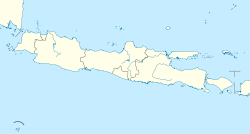Cipanas
| Cipanas | |
|---|---|
| Village | |
 |
|
| Nickname(s): Kota Bunga (Flower Town) | |
| Location of Cipanas within Java | |
| Coordinates: 6°43′59″S 107°02′27″E / 6.733035°S 107.040966°ECoordinates: 6°43′59″S 107°02′27″E / 6.733035°S 107.040966°E | |
| Country |
|
| Province | West Java |
| Regency | Cianjur |
| district | Cipanas |
| Established | 1740 |
| Government | |
| • Regent | Tjetjep Muchtar Soleh, MM |
| • District Chief | Muhamad Taufik Hidayat |
| Area | |
| • Total | 58.03 ha (143.40 acres) |
| Elevation | 1,080 m (3,540 ft) |
| Population (2010) | |
| • Total | 15,435 |
| • Density | 27,000/km2 (69,000/sq mi) |
| Time zone | WIB (UTC+7) |
| Postal Code | 43253 |
| Area code(s) | 0255 |
| Website | http://www.cianjurkab.go.id |
Cipanas ( Indonesian pronunciation: [tʃipanas] ) is the administrative village of Cipanas District, in the northern part of the Cianjur Regency, West Java, Indonesia. It is situated in the valley of Mount Gede, 86 kilometres (53 mi) south-east of the Indonesian capital city of Jakarta. The name of the village means "hot water" or "hot spring" in Sundanese (ci, water, panas, hot), due to the presence of sulphuric hot springs in the area.
The village had a population of 15,435 at the 2010 Census (the district held a population of 103,911). It is best known by the Istana Cipanas complex, a residence for former Dutch Governor Generals of the Dutch East Indies, and also a country retreat of former President Sukarno at Istana Cipanas. Since the Dutch colonial rule, and before the Enhanced Indonesian Spelling System was established, the village name was spelled Tjipanas.
The area already had a history of village dwellers since Sunda Kingdom and Banten Sultanate, long before the time the Presidential Palace was erected by a Dutch landlord named Van Heots in 1740. Out of interest in the local hot springs, during the administration of Dutch East India Company Governor General Gustaaf Willem van Imhoff (1743-1750), a health building was constructed near a hot spring. The reputation of the area for clean, fresh and cool mountain air led to the building being made into a resort for the Dutch Governor Generals.
...
Wikipedia

